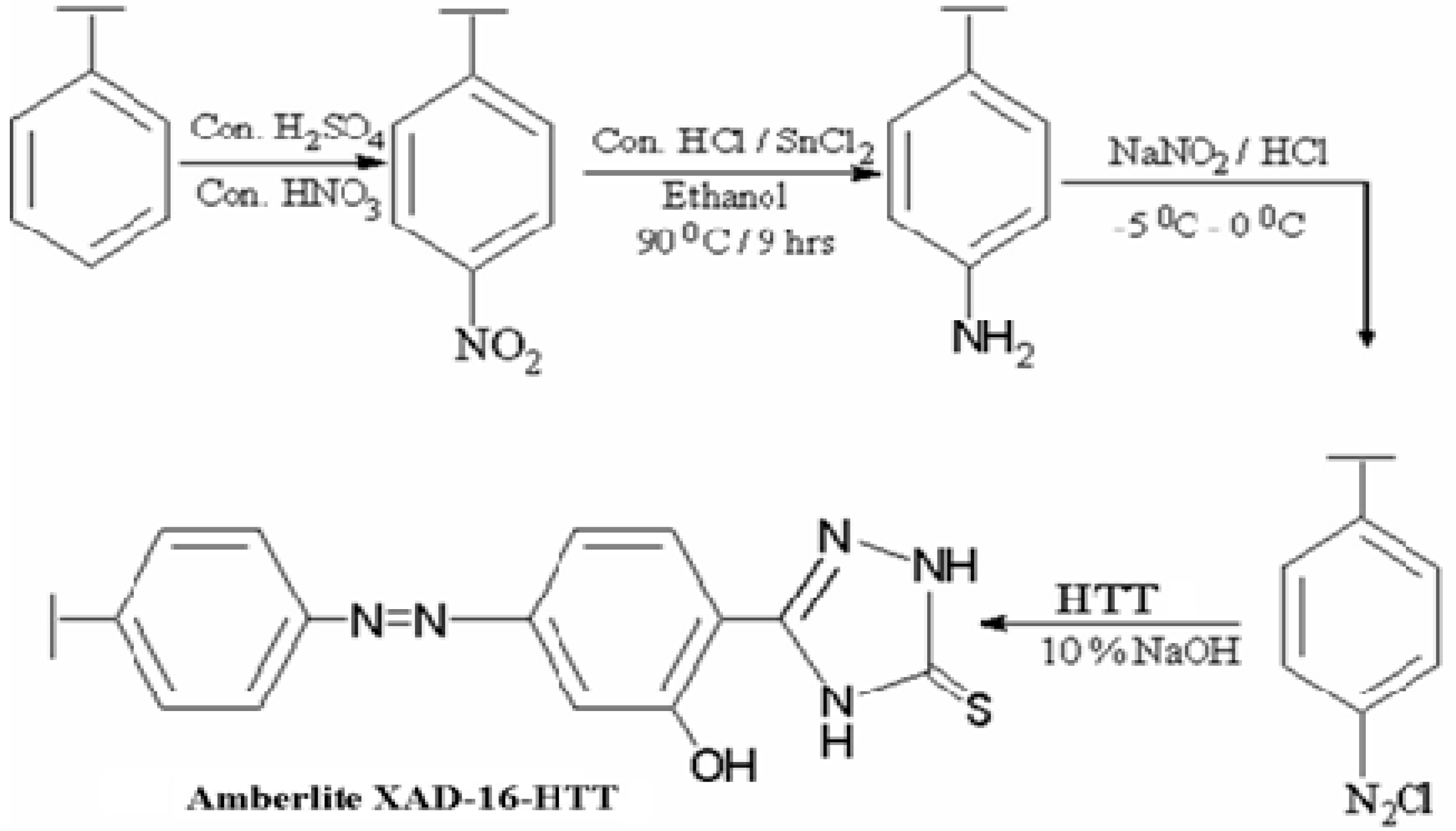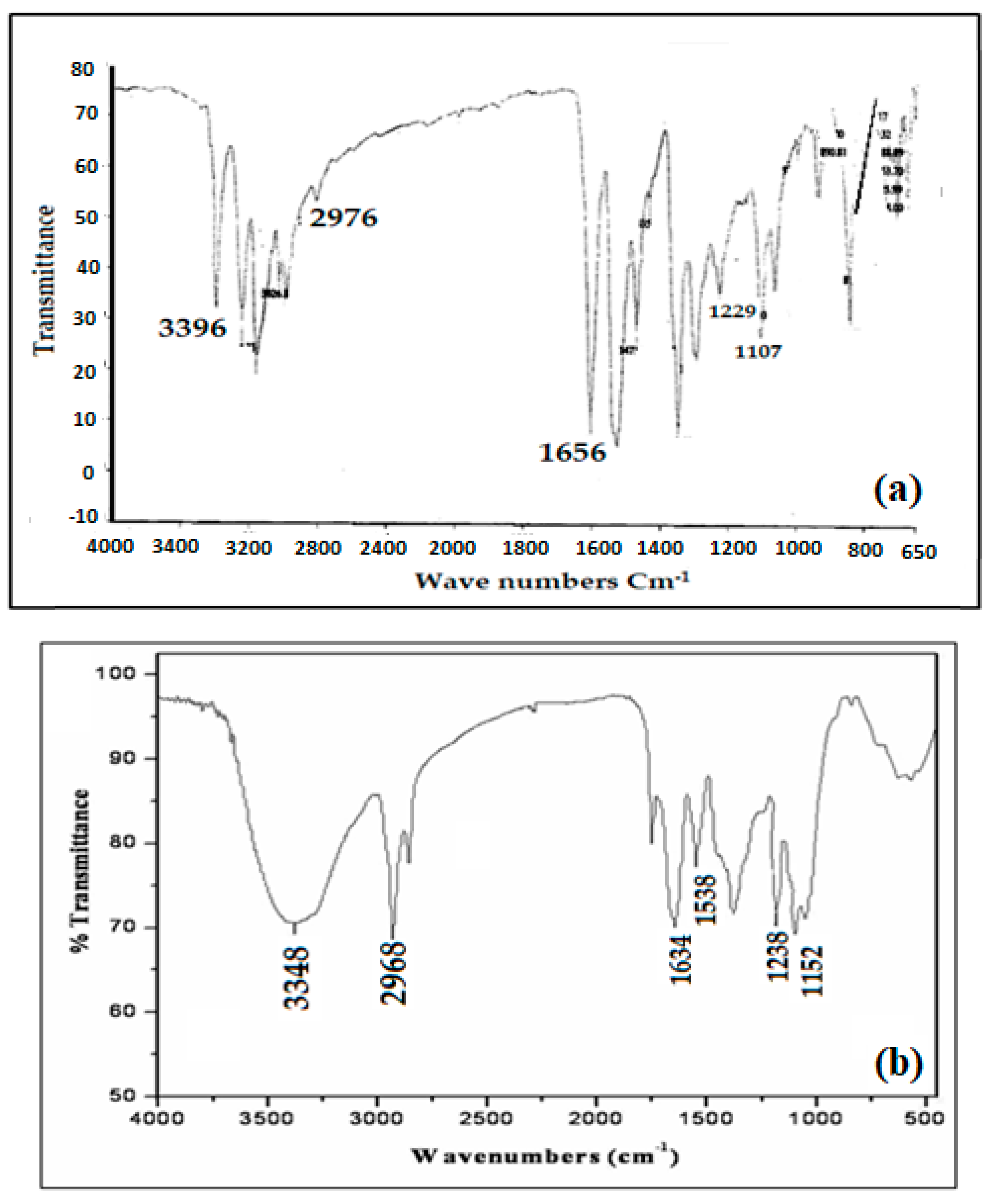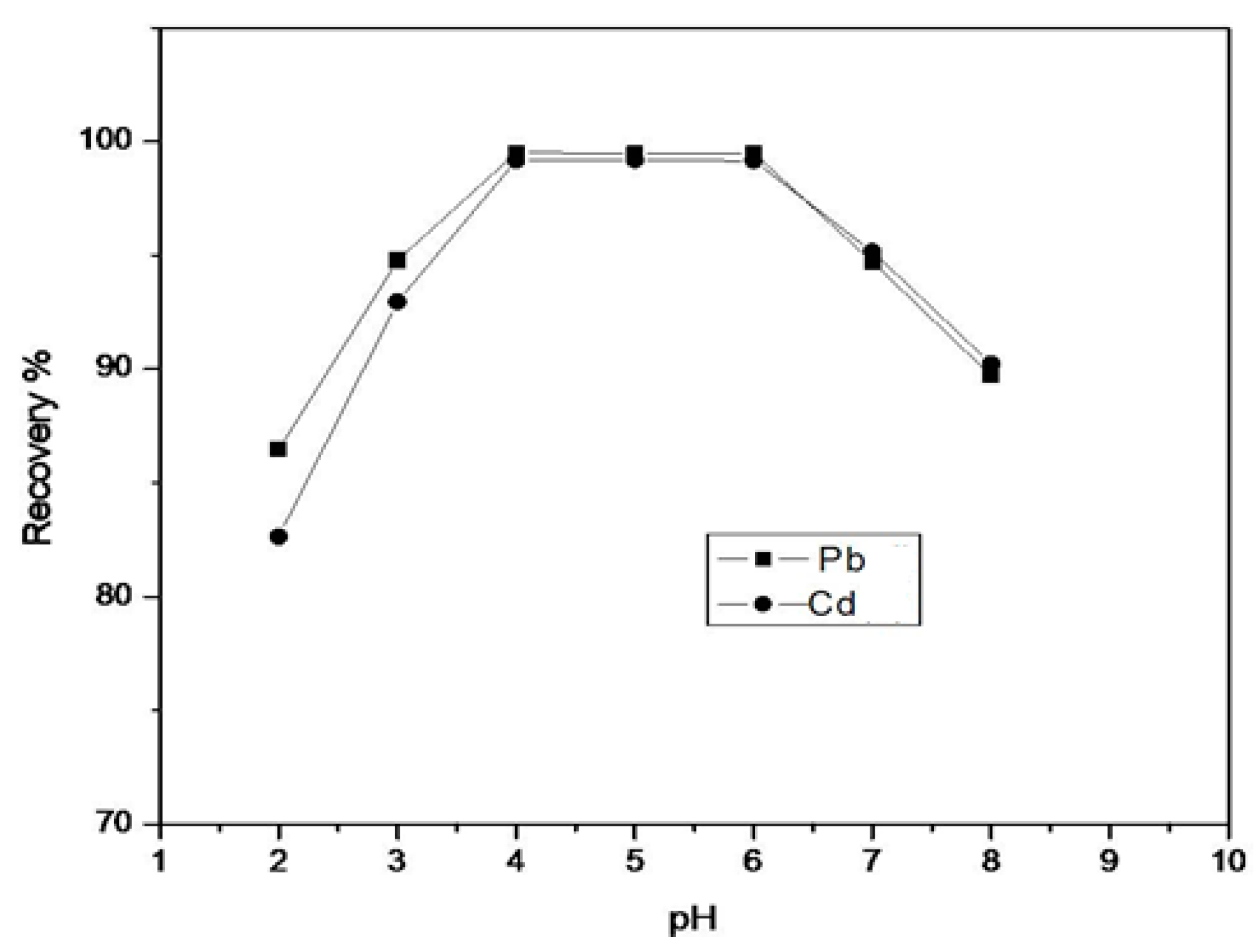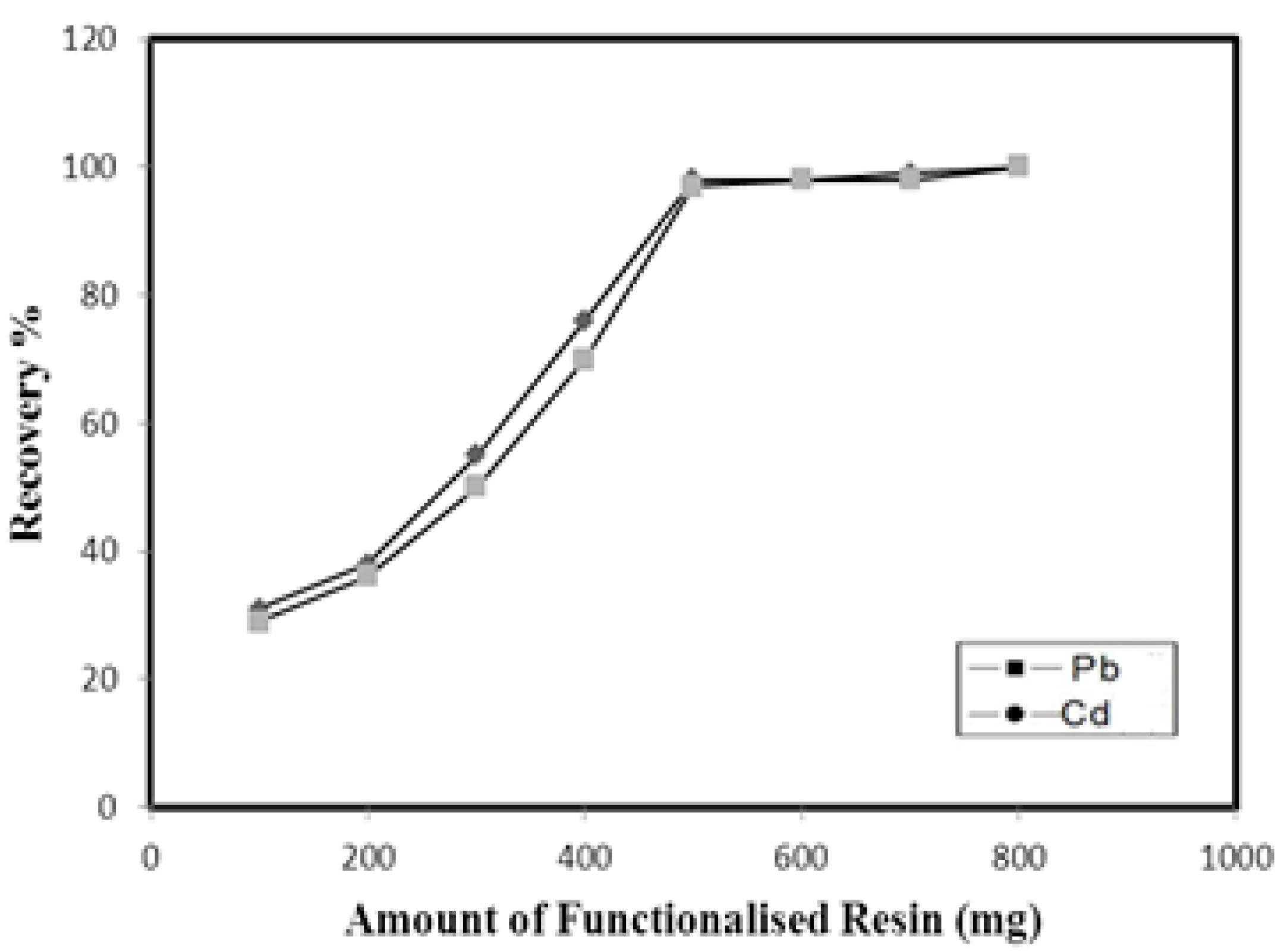Separation and Pre-Concentration of Pb and Cd in Water Samples Using 3-(2-hydroxyphenyl)-1H-1,2,4-triazole-5(4H)-thione (HTT) and Their Determination by Inductively Coupled Plasma Atomic Emission Spectrometry (ICP-AES)
Abstract
:1. Introduction
2. Materials and Methods
2.1. Apparatus
2.2. Chemicals and Solutions
2.3. Synthesis of 3-(2-hydroxyphenyl)-1H-1,2,4-triazole-5(4H)-thione (HTT)
2.4. Functionalization of Amberlite XAD-16 with HTT
2.5. Sample Collection
2.6. Solid-Phase Extraction (SPE)Procedure for the Pre-Concentration and Determination of Metal Ions
3. Results
3.1. Fourier Transform Infrared (FTIR) Spectral Analysis of HTT and Amberlite XAD-16-HTT
3.2. Effect of pH
3.3. Effect of the Amount of Resin on the Pre-Concentration of Metal Ions
3.4. Effect of Flow Rate
3.5. Eluent Selection and Concentration Optimization
3.6. Effect of Sample Volume
3.7. Sorption Capacity
3.8. Sorption Kinetics
3.9. Effect of Matrix Ions
3.10. Resin Stability and Reusability
3.10.1. Accuracy of the Method
3.10.2. Detection of Trace Metal Ions in Water Samples
3.10.3. Analytical Features
3.10.4. Comparison with Other Methods
4. Conclusions
Acknowledgments
Author Contributions
Conflicts of Interest
References
- US Environmental Protection Agency. SW846 On-Line, Methods for Chemical Analysis of Water and Wastes. Available online: https://www.epa.gov/hw#table (accessed on 19 January 2017).
- Balaram, V. Recent advances in the determination of elemental impurities in pharmaceuticals—Status, challenges and moving frontiers. Trends Anal. Chem. 2016, 80, 83–95. [Google Scholar] [CrossRef]
- Murata, I.; Hirono, T.; Saeki, Y.; Nakagawa, S. Cadmium enteropathy, renal osteomalacia (“ItaiItai” disease in Japan). Bull.Soc. Int. Chir. 1970, 29, 34–42. [Google Scholar] [PubMed]
- Spencer, D.W. Ocean disposal reconsidered. Oceanus 1990, 33, 4–12. [Google Scholar]
- Pereira, M.D.; Arruda, M.A.Z. Trends in preconcentration procedures for metal determination using atomic spectrometry techniques. Microchim. Acta 2003, 141, 115–131. [Google Scholar] [CrossRef]
- Ghaedi, M.; Fathi, M.R.; Shokrollahi, A.; Shajarat, F. Highly selective and sensitive preconcentration of mercury ion and determination by cold vapor atomic absorption spectroscopy. Anal. Lett. 2006, 39, 1171–1185. [Google Scholar] [CrossRef]
- Manjusha, R.; Dash, K.; Karunasagar, D. UV-photolysis assisted digestion of food samples for the determination of selenium by electrothermal atomic absorption spectrometry (ETAAS). Food Chem. 2007, 105, 260–265. [Google Scholar] [CrossRef]
- Mashhadizadeh, M.H.; Pesteh, M.; Talakesh, M.; Sheikhshoaie, I.; Ardakani, M.M.; Karimi, M.A. Solid phase extraction of copper(II) by sorption on octadecyl silica membrane disk modified with a new Schiff base and determination with atomic absorption spectrometry. Spectrochim. Acta Part B 2008, 63, 885–888. [Google Scholar] [CrossRef]
- Lemos, V.A.; DaSilva, D.G.; DeCarvalho, A.L.; Santana, D.D.; Novaes, G.D.; DosPassos, A.S. Synthesis of amberlite XAD-2-PC resin for preconcentration and determination of trace elements in food samples by flame atomic absorption spectrometry. Microchem. J. 2006, 84, 14–21. [Google Scholar] [CrossRef]
- Da-Col, J.A.; Domene, S.M.A.; Pereira-Filho, E.R. Fast determination of Cd, Fe, Pb, and Zn in food using AAS. Food Anal. Methods 2009, 2, 110–115. [Google Scholar] [CrossRef]
- Hammer, D.; Nicolas, M.; Andrey, D. Improved chromium determination in various food matrices using dynamic reaction cell ICP-MS. Atom.Spectrosc. 2005, 26, 203–208. [Google Scholar]
- Nardi, E.P.; Evangelista, F.S.; Tormen, L.; Pierre, T.D.S.; Curtius, A.J.; De-Souza, S.S.; Barbosa, F. The use of inductively coupled plasma mass spectrometry (ICP-MS) for the determination of toxic and essential elements in different types of food samples. Food Chem. 2009, 112, 727–732. [Google Scholar] [CrossRef]
- He, Q.; Chang, X.J.; Huang, X.P.; Hu, Z. Determination of trace elements in food samples by ICP-AES after preconcentration with p-toluenesulfonylamide immobilized on silica gel and nanometer SiO2. Microchim. Acta 2008, 160, 147–152. [Google Scholar] [CrossRef]
- Balaram, V.; Anjaiah, K.V.; Reddy, M.R.P. A comparative study on the trace and rare earth element analysis of an Indian polymetallic nodule reference sample by inductively coupled plasma atomic emission spectrometry and inductively coupled plasma mass spectrometry. Analyst 1995, 120, 1401–1406. [Google Scholar] [CrossRef]
- Balaram, V. Developments and trends in inductively coupled plasma mass spectrometry and its influence on the recent advances in trace metal analysis. Curr. Sci. 1995, 69, 640–649. [Google Scholar]
- Malvanker, P.L.; Shinde, V.M. Ion-pair extraction and determination of copper(II) and zinc(II) in environmental and pharmaceutical samples. Analyst 1991, 116, 1081–1084. [Google Scholar] [CrossRef]
- Divrikli, U.; Elci, L. Determination of some trace metals in water and sediment samples by flame atomic absorption spectrometry after coprecipitation with cerium(IV) hydroxide. Anal. Chim. Acta 2002, 452, 231–235. [Google Scholar] [CrossRef]
- Dumont, J.; Cote, M.; Hubert, J. Preconcentration of trace elements in aluminum alloys using a chelating ion-exchanger and determination by ICP-AES. Appl. Spectrosc. 1989, 43, 1132–1135. [Google Scholar] [CrossRef]
- Naresh Kumar, B.; Harinath, Y.; Seshaiah, K. Separation and preconcentration of Cd(II), Cu(II), Ni(II), and Pb(II) in water and food Samples using Amberlite XAD-2 functionalized with 3-(2-Nitrophenyl)-1H-1,2,4-triazole-5(4H)-thione and determination by Inductively Coupled Plasma–Atomic Emission Spectrometry. J. Agric. Food Chem. 2011, 59, 11352–11358. [Google Scholar]
- Suneetha, Y.; Naresh Kumar, B.; Harinath, Y.; Reddy, D.H.K.; Seshaiah, K. Functionalization of cross linked chitosan with 2-aminopyridine-3-carboxylic acid for solid phase extraction of cadmium and zinc ions and their determination by atomic absorption spectrometry. Microchim. Acta 2012, 176, 169–176. [Google Scholar] [CrossRef]
- Kumar, B.N.; Harinath, Y.; Sathyanarayana, B.; Suneeta, Y.; Seshaiah, K. Solid phase extraction of trace metals in water and leafy vegetables using a resin functionalized with potassium 2-benzoylhydrazinecarbodithioate and determination by ICP–AES. Int. J. Environ. Anal. Chem. 2012, 92, 1341–1351. [Google Scholar] [CrossRef]
- Tsogas, G.Z.; Giokas, D.L.; Vlessidis, A.G. Graphite furnace and hydride generation atomic absorption spectrometric determination of cadmium, lead, and tin traces in natural surface waters: Study of preconcentration technique performance. J. Hazard. Mater. 2009, 163, 988–994. [Google Scholar] [CrossRef] [PubMed]
- Sabarudin, A.; Noguchi, O.; Oshima, M.; Higuchi, K.; Motomizu, S. Application of chitosan functionalized with 3,4-dihydroxy benzoic acid moiety for on-line preconcentration and determination of trace elements in water samples. Microchim. Acta 2007, 159, 341–348. [Google Scholar] [CrossRef]
- Gentscheva, G.; Tzvetkova, P.; Vassileva, P.; Lakov, L.; Peshev, O.; Ivanova, E. Analytical characterization of a silica gel sorbent with thioetheric sites. Microchim. Acta 2006, 156, 303–306. [Google Scholar] [CrossRef]
- Lemos, V.A.; Baliza, P.X.; Santos, J.S. Synthesis of α-Nitroso-β-Naphthol modified Amberlite XAD-2 resin and its application in on-line solid phase extraction system for Cobalt pre-concentration. Sep. Sci. Technol. 2004, 39, 3317–3330. [Google Scholar] [CrossRef]
- Narin, I.; Soylak, M.; Kayakirilmaz, K.; Elci, L.; Dogan, M. Preparation of chelating resin by immobilizing 1-(2-pyridylazo) 2-naphtol on Amberlite XAD-16 and its application of solid phase extraction of Ni(II), Cd(II), Co(II), Cu(II), Pb(II), and Cr(III) in natural water samples. Anal. Lett. 2003, 36, 641–658. [Google Scholar] [CrossRef]
- Ramesh, A.; Mohan, K.R.; Seshaiah, K. Preconcentration of trace metals on Amberlite XAD-4 resin coated with dithiocarbamates and determination by inductively coupled plasma-atomic emission spectrometry in saline matrices. Talanta 2002, 57, 243–252. [Google Scholar] [CrossRef]
- Cuekicu, S.D.; Filik, H.; Apak, R. Use of an o-aminobenzoic acid-functionalized XAD-4 copolymer resin for the separation and preconcentration of heavy metal (II) ions. Anal. Chim. Acta 2004, 505, 15–24. [Google Scholar]
- Guo, Y.; Din, B.; Liu, Y.; Chang, X.; Meng, S.; Tian, M. Preconcentration of trace metals with 2-(methylthio)aniline-functionalized XAD-2 and their determination by flame atomic absorption spectrometry. Anal. Chim. Acta 2004, 504, 319–324. [Google Scholar] [CrossRef]
- Lemos, V.A.; Baliza, P.X. Amberlite XAD-2 functionalized with 2-aminothiophenol as a new sorbent for on-line preconcentration of cadmium and copper. Talanta 2005, 67, 564–570. [Google Scholar] [CrossRef] [PubMed]
- North, A.E.; Sarpong-Kumankomah, S.; Bellavie, A.R.; White, W.M.; Gailer, J. Environmentally relevant concentrations of aminopolycarboxylate chelating agents mobilize Cd from humic acid. J. Environ. Sci. 2017, 57, 249–257. [Google Scholar] [CrossRef] [PubMed]
- Narin, I.; Soylak, M.; Elci, L.; Dogan, M. Separation and enrichment of chromium, copper, nickel and lead in surface seawater samples on a column filled with Amberlite XAD-2000. Anal. Lett. 2004, 34, 1935–1947. [Google Scholar] [CrossRef]
- Uzun, A.; Soylak, M.; Elci, L. Preconcentration and separation with Amberlite XAD-4 resin; determination of Cu, Fe, Pb, Ni, Cd and Bi at trace levels in waste water samples by flame atomic absorption spectrometry. Talanta 2001, 54, 197–202. [Google Scholar] [CrossRef]
- Rao, G.P.C.; Seshaiah, K.; Rao, Y.K.; Wang, M.C. Solid phase extraction of Cd, Cu, and Ni from leafy vegetables and plant leaves using Amberlite XAD-2 functionalized with 2-Hydroxy-acetophenone-thiosemicarbazone (HAPTSC) and determination by inductively coupled plasma atomic emission spectroscopy. J. Agric. Food Chem. 2006, 54, 2868–2872. [Google Scholar] [CrossRef] [PubMed]






| Eluents | Pb | Cd |
|---|---|---|
| Recovery (%) | Recovery (%) | |
| 0.05 M HCl | 48.6 ± 2.7 a | 48.6 ± 2.8 |
| 0.1 M HCl | 82.3 ± 1.7 | 82.4 ± 1.7 |
| 0.5 M HCl | 97.5 ± 1.2 | 95.2 ± 1.7 |
| 1.0 M HCl | 97.7 ± 1.2 | 97.3 ± 1.3 |
| 0.05 M HNO3 | 51.4 ± 2.1 | 51.1 ± 3.2 |
| 0.1 M HNO3 | 84.4 ± 1.8 | 84.3 ± 1.9 |
| 0.5 M HNO3 | 99.3 ± 0.6 | 99.2 ± 0.6 |
| 1.0 M HNO3 | 99.8 ± 0.5 | 99.5 ± 0.4 |
| Volume of Sample (mL) | Pb | Cd |
|---|---|---|
| Recovery (%) | Recovery (%) | |
| 100 | 96.2 ± 0.9 a | 96.4 ± 0.7 |
| 250 | 96.7 ± 1.9 | 96.2 ± 0.9 |
| 500 | 99.1 ± 0.6 | 99.3 ± 0.5 |
| 750 | 94.3 ± 1.3 | 94.1 ± 1.4 |
| 1000 | 82.3 ± 1.9 | 81.2 ± 1.8 |
| Matrix | Tolerance Limit | Recovery (%) | Matrix | Tolerance Limit | Recovery (%) | ||
|---|---|---|---|---|---|---|---|
| Ion | (mg/L) | Pb | Cd | Ion | (mg/L) | Pb | Cd |
| Na+ | 28,000 | 98.1 ± 1.1 a | 97.6 ± 1.2 a | CH3COO− | 10,000 | 95.4 ± 1.2 | 97.1 ± 1.4 |
| K+ | 24,000 | 97.2 ± 1.4 | 95.4 ± 0.8 | PO43− | 2500 | 95.1 ± 1.7 | 94.1 ± 1.9 |
| Ca2+ | 20,000 | 96.8 ± 0.9 | 95.0 ± 1.1 | SO42− | 16,000 | 96.4 ± 1.5 | 94.8 ± 0.7 |
| Mg2+ | 18,000 | 96.3 ± 0.8 | 95.2 ± 1.2 | Al3+ | 100 | 95.4 ± 1.2 | 96.2 ± 0.6 |
| Cl− | 23,000 | 98.5 ± 1.6 | 96.8 ± 1.8 | Cr6+ | 51 | 95.1 ± 1.4 | 94.8 ± 1.1 |
| NO3− | 14,000 | 97.3 ± 1.8 | 95.0 ± 0.4 | Zn2+ | 40 | 95.6 ± 0.9 | 98.2 ± 0.4 |
| HCO3− | 10,000 | 95.2 ± 1.3 | 98.0 ± 1.0 | Co2+ | 44 | 97.4 ± 1.2 | 97.9 ± 0.8 |
| Element | NIST 1643e Water (μg/L) | |
|---|---|---|
| Certified Value | Proposed Method | |
| Pb | 19.63 ± 0.25 | 19.56 ± 0.24 a |
| Cd | 6.57 ± 0.42 | 6.47 ± 0.26 a |
| Sample | ICP-AES Method (μg/L) | ||
|---|---|---|---|
| Natural Water | River Water | Sea Water | |
| Pb | 8.66 ± 0.25 a | 15.48 ± 0.55 | 7.40 ± 0.22 |
| Cd | 7.14 ± 0.16 a | 1.95 ± 0.23 | 0.74 ± 0.15 |
| Parameters (Units) | Pb | Cd |
|---|---|---|
| Detection limit (µg/L) (n = 10) | 0.16 | 0.22 |
| Recovery (%) (n = 5) | 99.1 | 99.8 |
| Standard deviation (%) (n = 5) | 1.8 | 2.3 |
| Pre-Concentration System | Analytes | Technique | Flow Rates (mL/min) | PF (Pre-Concentration Factor) | Detection Limit (μg/L) | Ref. |
|---|---|---|---|---|---|---|
| Amberlite XAD-4/dithiocarbamates | Cd(II), Cu(II), Mn(II), Ni(II), Pb(II), Zn(II) | ICP-AES | - | 230 for Cu(II); 120 for Mn(II); 215 for Zn(II) | 0.4 for Cu(II); 0.3 for Mn(II); 0.5 for Zn(II) | [25] |
| XAD–2000/1-(2-pyridylazo)-2-naphthol (PAN) | Cr(III), Cu(II), Ni(II), Pb(II) | FAAS | 10 | 250 | - | [32] |
| Amberlite XAD-4/DDTC | Cu, Fe, Pb, Ni, Cd, Bi | FAAS | 10 | 150 | 4 | [33] |
| Amberlite XAD-2-HAPTSC | Cd(II), Cu(II), Ni(II) | ICP-AES | 2.5 | - | 0.54 for Ni(II); 0.61 for Cu(II) | [34] |
| Amberlite XAD-16-HTT | Pb(II), Cd(II) | ICP-AES | 2.5 | 50 | 0.16 for Pb(II) 0.22 for Cd(II) | Present Study |
© 2017 by the authors. Licensee MDPI, Basel, Switzerland. This article is an open access article distributed under the terms and conditions of the Creative Commons Attribution (CC BY) license (http://creativecommons.org/licenses/by/4.0/).
Share and Cite
Kumar, N.S.; Dharmendra, V.; Sreenivasulu, V.; Asif, M.; Ibrahim, A.A.; Balaram, V. Separation and Pre-Concentration of Pb and Cd in Water Samples Using 3-(2-hydroxyphenyl)-1H-1,2,4-triazole-5(4H)-thione (HTT) and Their Determination by Inductively Coupled Plasma Atomic Emission Spectrometry (ICP-AES). Metals 2017, 7, 240. https://doi.org/10.3390/met7070240
Kumar NS, Dharmendra V, Sreenivasulu V, Asif M, Ibrahim AA, Balaram V. Separation and Pre-Concentration of Pb and Cd in Water Samples Using 3-(2-hydroxyphenyl)-1H-1,2,4-triazole-5(4H)-thione (HTT) and Their Determination by Inductively Coupled Plasma Atomic Emission Spectrometry (ICP-AES). Metals. 2017; 7(7):240. https://doi.org/10.3390/met7070240
Chicago/Turabian StyleKumar, Nadavala Siva, Vummiti Dharmendra, Vudagandla Sreenivasulu, Mohammad Asif, Ahmed A. Ibrahim, and Vysetti Balaram. 2017. "Separation and Pre-Concentration of Pb and Cd in Water Samples Using 3-(2-hydroxyphenyl)-1H-1,2,4-triazole-5(4H)-thione (HTT) and Their Determination by Inductively Coupled Plasma Atomic Emission Spectrometry (ICP-AES)" Metals 7, no. 7: 240. https://doi.org/10.3390/met7070240






